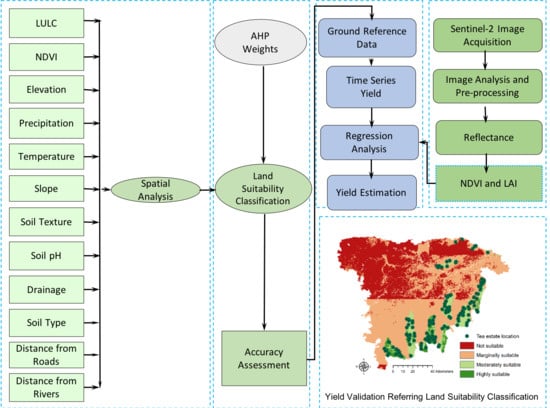Integrating an Expert System, GIS, and Satellite Remote Sensing to Evaluate Land Suitability for Sustainable Tea Production in Bangladesh
Abstract
:1. Introduction
2. Materials and Methods
2.1. Study Area
2.2. Criteria for Suitability Analysis
2.2.1. Land Use and Land Cover
2.2.2. Normalized Difference Vegetation Index (NDVI)
2.2.3. Elevation
2.2.4. Precipitation
2.2.5. Temperature
2.2.6. Slope
2.2.7. Soil Texture
2.2.8. Soil pH
2.2.9. Drainage
2.2.10. Soil Type
2.2.11. Distance from Roads
2.2.12. Distance from Rivers
2.3. Digital Image Processing
2.3.1. NDVI Computation
2.3.2. LAI Computation
2.4. Reclassification of Criteria
2.5. Analytical Hierarchy Process (AHP)
2.6. Land Suitability Evaluation
2.7. Ground Reference Information and Field Survey
2.8. Validation of Yield
3. Results
3.1. Reclassification
3.2. AHP Weights
3.3. Land Suitability
3.4. Validation of Yield
4. Discussion
5. Conclusions
Author Contributions
Funding
Acknowledgments
Conflicts of Interest
Appendix A
| Criteria | Suitability Class | Sub-Criteria | Reference |
|---|---|---|---|
| LULC | S1 | Tea estates | [57,58] |
| S2 | Forest | [28,57,58] | |
| S3 | High agricultural land | [57] | |
| N | Settlements, water bodies, rivers, and wetlands | [6,59] | |
| NDVI | S1 | >0.6 | [60] |
| S2 | 0.4–0.6 | [60] | |
| S3 | 0.4 | [60] | |
| N | <0 | [60] | |
| Elevation | S1 | >15 m | [1,28] |
| S2 | 10–15 m | [1,28] | |
| S3 | 7–10 m | [1,28] | |
| N | <7 m | [1,28] | |
| Precipitation | S1 | >1800 mm | [22] |
| S2 | 1600–1800 mm | [22] | |
| S3 | 1000–1600 mm | [22] | |
| Temperature | S1 | 18–25 °C | [22] |
| Slope | S1 | 5–25° | [1] |
| S2 | <5° | [1] | |
| S3 | >25° | [1] | |
| Soil Texture | S1 | scl, l, cl, sl | [22] |
| S2 | c, sicl, sic | [22] | |
| S3 | c(ss), ls, s | [22] | |
| Soil pH | S1 | 4.5–5.5 | [1,33,35,36] |
| S2 | 5.5–7.3 | [1,33,35,36] | |
| S3 | 7.3–8.4 | [1,33,35,36] | |
| Drainage | S1 | Moderately well drained to well drained | [19,61] |
| S2 | Imperfectly drained | [19,61] | |
| S3 | Poorly drained | [19,61] | |
| N | Very poorly drained | [61] | |
| Soil type | S1 | Brown hill soils | [41] |
| S2 | Gray piedmont soils | [42,43] | |
| S3 | Non-calcareous alluvium, Brown flood plain soils, Dark gray flood plain soils, Gray flood plain soils, Acid basin clays, Deep-red brown terrace soils | [41,44,45,46] | |
| N | Peat, Water bodies, Urban | [46] | |
| Distance from roads | S1 | 0–1.0 km | [47] |
| S2 | 1.0–2.0 km | [47] | |
| S3 | 2.0–4.0 km | [47] | |
| N | >4.0 km | [47] | |
| Distance from rivers | S1 | 0–0.5 km | [47] |
| S2 | 0.5–1.0 km | [47] | |
| S3 | 1.0–2.0 km | [47] | |
| N | >2.0 km | [47] |
References
- Jayasinghe, S.L.; Kumar, L.; Sandamali, J. Assessment of potential land suitability for tea (Camellia sinensis (L.) O. Kuntze) in Sri Lanka using a GIS-based multi-criteria approach. Agriculture 2019, 9, 148. [Google Scholar] [CrossRef] [Green Version]
- Ahamed, T.N.; Rao, K.G.; Murthy, J.S.R. GIS-based fuzzy membership model for crop-land suitability analysis. Agric. Syst. 2000, 63, 75–95. [Google Scholar] [CrossRef]
- Wang, F.; Brent Hall, G.; Subaryono. Fuzzy information representation and processing in conventional GIS software: Database design and application. Int. J. Geogr. Inf. Syst. 1990, 4, 261–283. [Google Scholar] [CrossRef]
- McDowell, R.W.; Snelder, T.; Harris, S.; Lilburne, L.; Larned, S.T.; Scarsbrook, M.; Curtis, A.; Holgate, B.; Phillips, J.; Taylor, K. The land use suitability concept: Introduction and an application of the concept to inform sustainable productivity within environmental constraints. Ecol. Indic. 2018, 91, 212–219. [Google Scholar] [CrossRef]
- Food and Agriculture Organization. A Framework for Land Evaluation; FAO: Rome, Italy, 1976. [Google Scholar]
- Purnamasari, R.A.; Ahamed, T.; Noguchi, R. Land suitability assessment for cassava production in Indonesia using GIS, remote sensing and multi-criteria analysis. Asia-Pac. J. Reg. Sci. 2019, 3, 1–32. [Google Scholar] [CrossRef]
- Habibie, M.I.; Noguchi, R.; Shusuke, M.; Ahamed, T. Land suitability analysis for maize production in Indonesia using satellite remote sensing and GIS-based multicriteria decision support system. GeoJournal 2019, 1–31. [Google Scholar] [CrossRef]
- Vitousek, P.M. Beyond global warming: Ecology and global change. Ecology 1994, 75, 1861–1876. [Google Scholar] [CrossRef]
- Gunathilaka, R.D.; Smart, J.C.; Fleming, C.M. The impact of changing climate on perennial crops: The case of tea production in Sri Lanka. Clim. Chang. 2017, 140, 577–592. [Google Scholar] [CrossRef]
- Lambert, J.D.; Yang, C.S. Mechanisms of cancer prevention by tea constituents. J. Nutr. 2003, 133, 3262–3267. [Google Scholar] [CrossRef]
- Cooper, R.; Morre, D.J.; Morre, D.M. Medicinal benefits of green tea: Part II. Review of anti-cancer properties. J. Alter. Complem. Med. 2005, 11, 639–652. [Google Scholar] [CrossRef]
- Bhattacharya, A.; Saini, U.; Joshi, R.; Kaur, D.; Pal, A.K.; Kumar, N.; Gulati, A.; Mohanpuria, P.; Yadav, S.K.; Kumar, S.; et al. Osmotin-expressing transgenic tea plants have improved stress tolerance and are of higher quality. Transgenic Res. 2014, 23, 211–223. [Google Scholar] [CrossRef] [PubMed]
- Islam, M.N.; Al-Amin, M. Life behind leaves: Capability, poverty and social vulnerability of tea garden workers in Bangladesh. Labor Hist. 2019, 60, 571–587. [Google Scholar] [CrossRef]
- Bangladesh Tea Board. Statistical Handbook on Bangladesh Tea Industry 2019; Project Development Unit; Bangladesh Tea Board: Sylhet, Bangladesh, 2020; Volume 8, pp. 1–146. [Google Scholar]
- Kamruzzaman, M.; Parveen, S.; Das, A.C. Livelihood improvement of tea garden workers: A scenario of marginalized women group in Bangladesh. Asian J. Agric. Ext. Econ. Soc. 2015, 7, 1–7. [Google Scholar] [CrossRef]
- International Tea Committee. Annual Bulletin of Statistics; International Tea Committee Ltd.: London, UK, 2017. [Google Scholar]
- Bandyopadhyay, S.; Jaiswal, R.K.; Hegde, V.S.; Jayaraman, V. Assessment of land suitability potentials for agriculture using a remote sensing and GIS based approach. Int. J. Remote Sens. 2009, 30, 879–895. [Google Scholar] [CrossRef]
- Clevers, J.G.P.W.; Büker, C.; Van Leeuwen, H.J.C.; Bouman, B.A.M. A framework for monitoring crop growth by combining directional and spectral remote sensing information. Remote Sens. Environ. 1994, 50, 161–170. [Google Scholar] [CrossRef]
- Nguyen, H.; Nguyen, T.; Hoang, N.; Bui, D.; Vu, H.; Van, T. The application of LSE software: A new approach for land suitability evaluation in agriculture. Comput. Electron. Agric. 2020, 173, 1–16. [Google Scholar] [CrossRef]
- Li, B.; Zhang, F.; Zhang, L.W.; Huang, J.F.; Jin, Z.F.; Gupta, D.K. Comprehensive suitability evaluation of tea crops using GIS and a modified land ecological suitability evaluation model. Pedosphere 2012, 22, 122–130. [Google Scholar] [CrossRef]
- Chanhda, H.; Wu, C.F.; Ye, Y.M.; Ayumi, Y. GIS based land suitability assessment along Laos-China border. J. Forest. Res. 2010, 21, 343–349. [Google Scholar] [CrossRef]
- Gahlod, N.S.; Binjola, S.; Ravi, R.; Arya, V.S. Land-site suitability evaluation for tea, cardamom and rubber using Geo-spatial technology in Wayanad district, Kerala. J. Appl. Nat. Sci. 2017, 9, 1440–1447. [Google Scholar] [CrossRef] [Green Version]
- Collette, B.B.; Nauen, C.E. FAO Species Catalogue; Scombrids of the World; An Annotated and Illustrated Catalogue of Tunas, Mackerels, Bonitos and Related Species Known to Date; FAO Fisheries Synopsis, Food and Agriculture Organization of the United Nations: Rome, Italy, 1983; Volume 2, pp. 1–137. ISBN 92-5-101381-0. [Google Scholar]
- Kamruzzaman, M.; Shaw, R. Flood and sustainable agriculture in the Haor basin of Bangladesh: A review paper. Univ. J. Agric. Res. 2018, 6, 40–49. [Google Scholar] [CrossRef] [Green Version]
- Rouse, J.W.; Haas, R.H.; Schell, J.A.; Deering, D.W. Monitoring Vegetation Systems in the Great Plains with ERTS. In Proceedings of the Third Earth Resources Technology Satellite—1 Symposium, Goddard Space Flight Center, Greenbelt, MD, USA, 10–14 December 1973; NASA SP-351. pp. 309–317. Available online: https://ntrs.nasa.gov/citations/19740022614 (accessed on 16 December 2020).
- Romano, G.; Ricci, G.F.; Gentile, F. Influence of different satellite imagery on the analysis of riparian leaf density in a mountain stream. Remote Sens. 2020, 12, 3376. [Google Scholar] [CrossRef]
- Phan, P.; Chen, N.; Xu, L.; Chen, Z. Using Multi-Temporal MODIS NDVI Data to monitor tea Status and forecast yield: A case study at Tanuyen, Laichau, Vietnam. Remote Sens. 2020, 12, 1814. [Google Scholar] [CrossRef]
- Hajiboland, R. Environmental and nutritional requirements for tea cultivation. Folia Hort. 2017, 29, 199–220. [Google Scholar] [CrossRef] [Green Version]
- Bozdağ, A.; Yavuz, F.; Günay, A.S. AHP and GIS based land suitability analysis for Cihanbeyli (Turkey) County. Environ. Earth Sci. 2016, 75, 813. [Google Scholar] [CrossRef]
- Ahmed, S.; Stepp, J.R.; Orians, C.; Griffin, T.; Matyas, C.; Robbat, A.; Buckley, S. Effects of extreme climate events on tea (Camellia sinensis) functional quality validate indigenous farmer knowledge and sensory preferences in tropical China. PLoS ONE 2014, 9, e109126. [Google Scholar] [CrossRef] [Green Version]
- Khormali, F.; Ayoubi, S.; Foomani, F.K.; Fatemi, A. Tea yield and soil properties as affected by slope position and aspect in Lahijan area, Iran. Int. J. Plant. Prod. 2012, 1, 99–111. [Google Scholar] [CrossRef]
- Zhang, W.L.; Xie, H.; Li, T.; Wang, D.D. Effects of different soil texture and management pattern on soil properties and tea quality of tea garden. Hubei Agric. Sci. 2017, 10, 7. [Google Scholar]
- Natesan, S. Tea soils. In Global Advances in Tea Science; Jain, N.K., Ed.; Aravali Books International Pty Ltd.: New Delhi, India, 1999. [Google Scholar]
- Foy, C.D.; Chaney, R.L.; White, M.C. The physiology of metal toxicity in plants. Ann. Rev. Plant. Physiol. 1978, 29, 511–526. [Google Scholar] [CrossRef]
- Sultana, J.; Siddique, M.N.A.; Kamaruzzaman, M.; Halim, M.A. Conventional to ecological: Tea plantation soil Management in Panchagarh district of Bangladesh. J. Sci. Technol. Environ. Inform. 2014, 1, 27–37. [Google Scholar] [CrossRef]
- Hussain, S.G.; Chowdhury, M.K.A.; Chowdhury, M.A.H. Land Suitability Assessment and Crop. Zoning of Bangladesh; Bangladesh Agricultural Research Council (BARC): Farmgate, Dhaka, Bangladesh, 2012; pp. 1–110. [Google Scholar]
- Parthasarathy, V.A.; Chattopadhyay, P.K.; Bose, T.K. Plantation Crops-I; Naya Udyog: Calcutta, India, 2006; ISBN 13: 9788185971971. [Google Scholar]
- Mukhopadhyay, M.; Mondal, T.K. Cultivation, improvement, and environmental impacts of tea. Oxford Res. Encycl. Environ. Sci. 2017. [Google Scholar] [CrossRef]
- Rama Rao, N.; Kapoor, M.; Sharma, N.; Venkateswarlu, K. Yield prediction and waterlogging assessment for tea plantation land using satellite image-based techniques. Int. J. Remote Sens. 2007, 28, 1561–1576. [Google Scholar] [CrossRef]
- Bhagat, R.M.; Baruah, R.D.; Safique, S. Climate and Tea [Camellia sinensis (L.) O. Kuntze] Production with Special Reference to North Eastern India: A Review. J. Environ. Res. Develop. 2010, 4, 1017–1028. Available online: https://www.cabdirect.org/cabdirect/abstract/2011322704 (accessed on 16 December 2020).
- Egashira, K.; Aramaki, K.; Yoshimasa, M.; Takeda, A.; Yamasaki, S.I. Variation of rare earth element of soils in the process of soil formation. Clay Sci. 2007, 13, 117–124. [Google Scholar] [CrossRef]
- Prokop, P.; Ploskonka, D. Natural and human impact on the land use and soil properties of the Sikkim Himalayas piedmont in India. J. Environ. Manag. 2014, 138, 15–23. [Google Scholar] [CrossRef] [PubMed] [Green Version]
- Akhtaruzzaman, M.; Haque, M.E.; Osman, K.T. Morphological, physical and chemical characteristics of hill forest soils at Chittagong University, Bangladesh. Open J. Soil Sci. 2014, 4, 26–35. [Google Scholar] [CrossRef] [Green Version]
- Egashira, K.; Hagimine, M.; Moslehuddin, A.Z.M. Fixed ammonium in some Bangladesh soils. Soil Sci. Plant. Nutr. 1998, 44, 269–272. [Google Scholar] [CrossRef]
- Bhuiya, Z.H. Organic matter status and organic recycling in Bangladesh soils. Resour. Conserv. 1987, 13, 117–124. [Google Scholar] [CrossRef]
- Islam, M.A.; Hasan, M.A.; Farukh, M.A. Application of GIS in general soil mapping of Bangladesh. J. Geogr. Inform. Syst. 2017, 9, 604–621. [Google Scholar] [CrossRef] [Green Version]
- Pramanik, M.K. Site suitability analysis for agricultural land use of Darjeeling district using AHP and GIS techniques. Model. Earth Syst. Environ. 2016, 2, 1–22. [Google Scholar] [CrossRef] [Green Version]
- Tewari, S.; Kulhavy, J.; Rock, B.N.; Hadas, P. Remote monitoring of forest response to changed soil moisture regime due to river regulation. J. For. Sci. 2003, 49, 429–438. [Google Scholar] [CrossRef] [Green Version]
- Tuvshinbayar, D.; Erdenetuya, B.; Erkhembayar, E.; Batbileg, B.; Sarangerel, J. Some Results of crop stress monitoring by remote sensing in northern Mongolia. Mong. J. Agric. Sci. 2017, 21, 59–63. [Google Scholar] [CrossRef] [Green Version]
- Saaty, T.L. How to make a decision: The analytic hierarchy process. Eur. J. Operat. Res. 1990, 48, 9–26. [Google Scholar] [CrossRef]
- Saaty, T.L. Group decision making and the AHP. In The Analytic Hierarchy Process; Golden, B.L., Wasil, E.A., Harker, P.T., Eds.; Springer: Berlin/Heidelberg, Germany, 1989. [Google Scholar]
- Aldababseh, A.; Temimi, M.; Maghelal, P.; Branch, O.; Wulfmeyer, V. Multi-criteria evaluation of irrigated agriculture suitability to achieve food security in an arid environment. Sustainability 2018, 10, 803. [Google Scholar] [CrossRef] [Green Version]
- Rashid, M.F.A. Capabilities of a GIS-based multi-criteria decision analysis approach in modelling migration. GeoJournal 2019, 84, 483–496. [Google Scholar] [CrossRef]
- Hinton, J.C. GIS and remote sensing integration for environmental applications. Int. J. Geogr. Inf. Syst. 2007, 10, 877–890. [Google Scholar] [CrossRef]
- Amarathunga, S.L.D.; Panabokke, C.R.; Pathiranage, S.R.W.; Amarasinghe, L.; Wijeratne, M.A. Land suitability classification and mapping of tea lands in Ratnapura district. Sri Lanka J. Tea Sci. 2008, 73, 1–10. [Google Scholar]
- Elsheikh, R.; Shariff, A.R.B.M.; Amiri, F.; Ahmad, N.B.; Balasundram, S.K.; Soom, M.A.M. Agriculture Land Suitability Evaluator (ALSE): A decision and planning support tool for tropical and subtropical crops. Comput. Electron. Agric. 2013, 93, 98–110. [Google Scholar] [CrossRef] [Green Version]
- Su, S.; Wan, C.; Li, J.; Jin, X.; Pi, J.; Zhang, Q.; Weng, M. Economic benefit and ecological cost of enlarging tea cultivation in subtropical China: Characterizing the trade-off for policy implications. Land Use Policy 2017, 66, 183–195. [Google Scholar] [CrossRef]
- Su, S.; Zhou, X.; Wan, C.; Li, Y.; Kong, W. Land use changes to cash crop plantations: Crop types, multilevel determinants and policy implications. Land Use Policy 2016, 50, 379–389. [Google Scholar] [CrossRef]
- Pezeshki, S.R. Wetland plant responses to soil flooding. Environ. Exp. Bot. 2001, 46, 299–312. [Google Scholar] [CrossRef]
- Choudhary, K.; Shi, W.; Boori, M.S.; Corgne, S. Agriculture phenology monitoring using NDVI time series based on remote sensing satellites: A case study of Guangdong, China. Optic. Memory Neural Netw. 2019, 28, 204–214. [Google Scholar] [CrossRef]
- Sys, C.; Van Ranst, E.; Debaveye, J.; Beernaert, F. Land Evaluation—Part. III—Crop. Requirements; Agricultural Publications-No. 7; General Administration for Development Cooperation: Brussels, Belgium, 1993; Available online: http://hdl.handle.net/1854/LU-233235 (accessed on 16 December 2020).
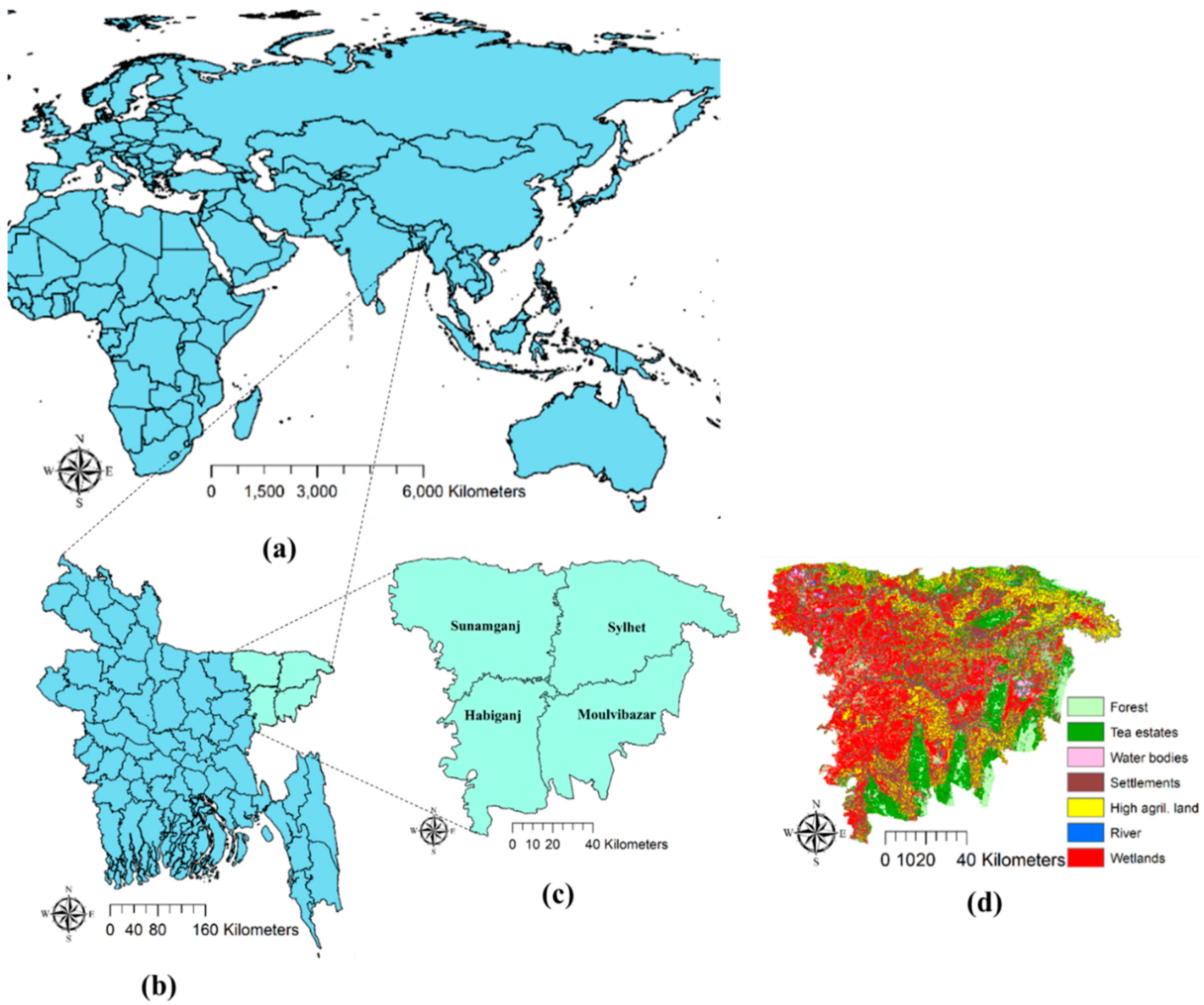
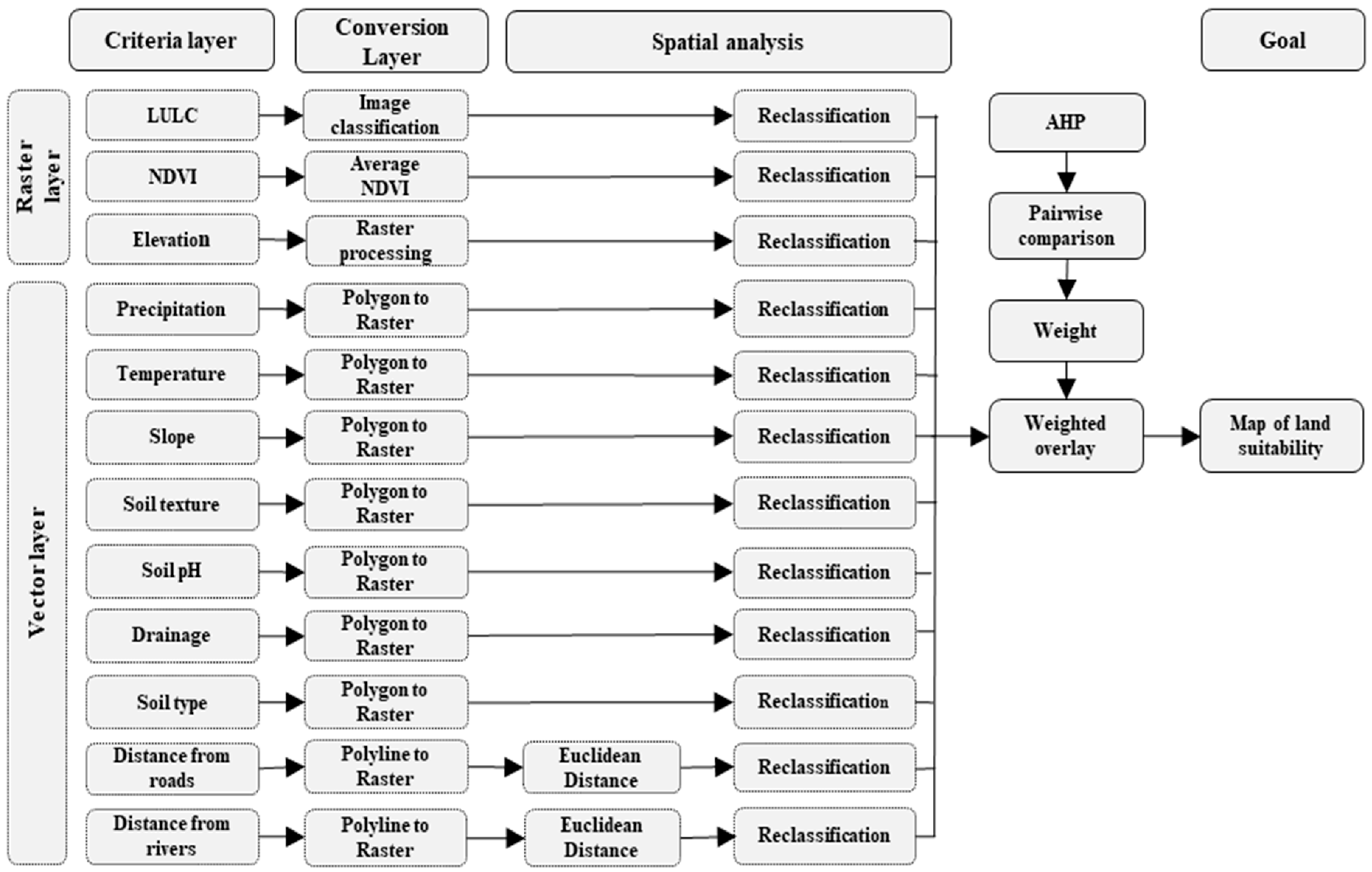
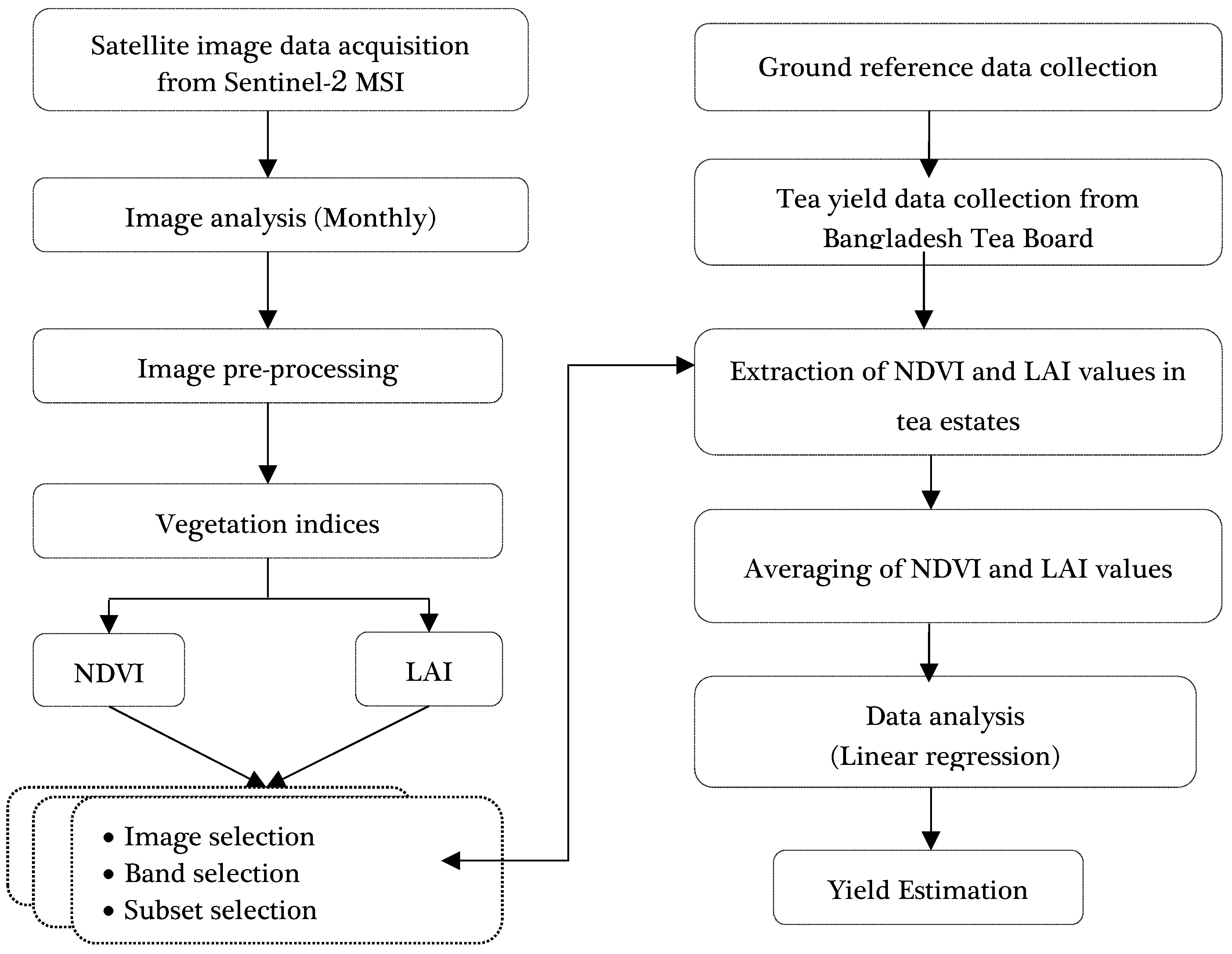
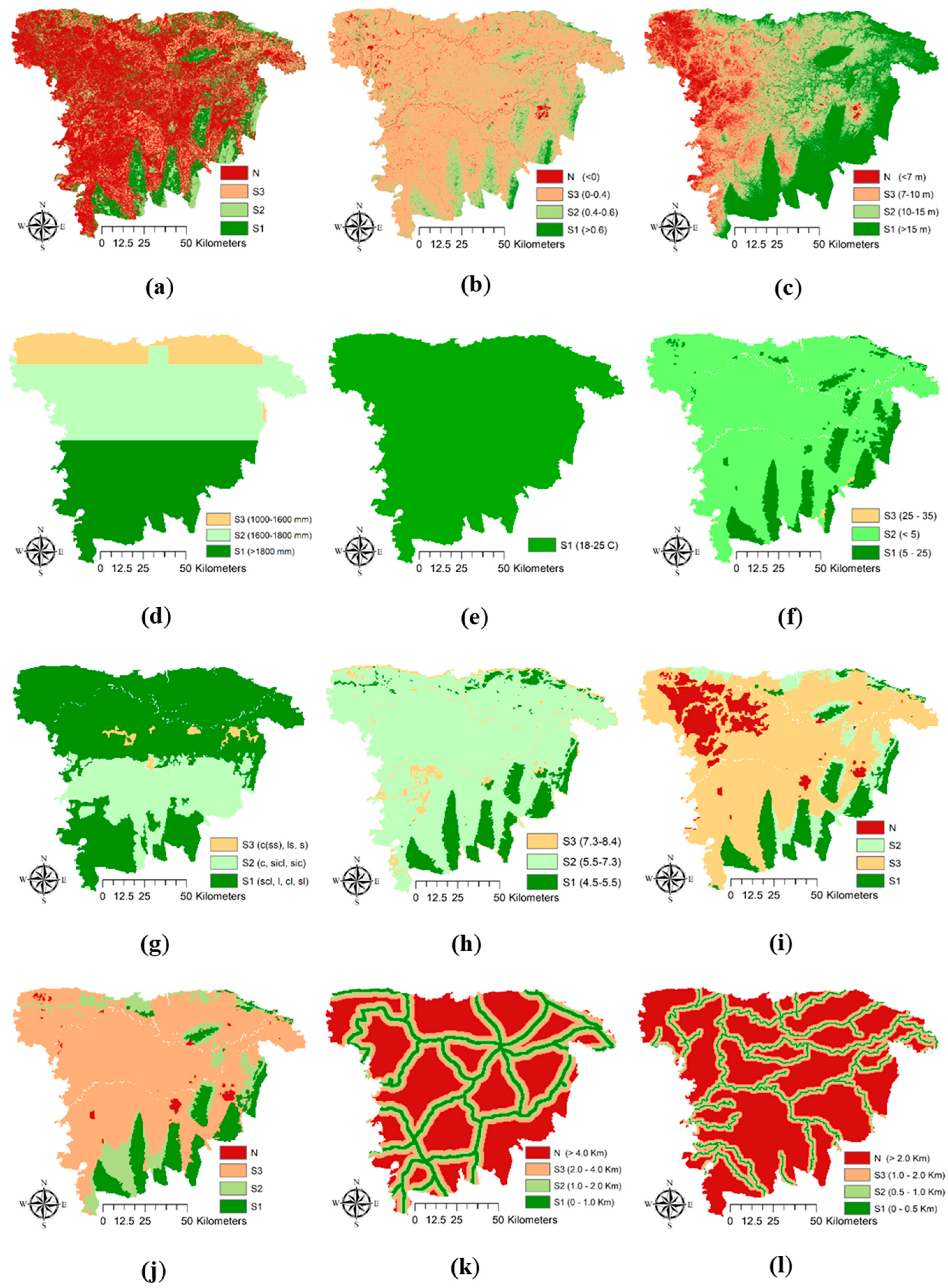
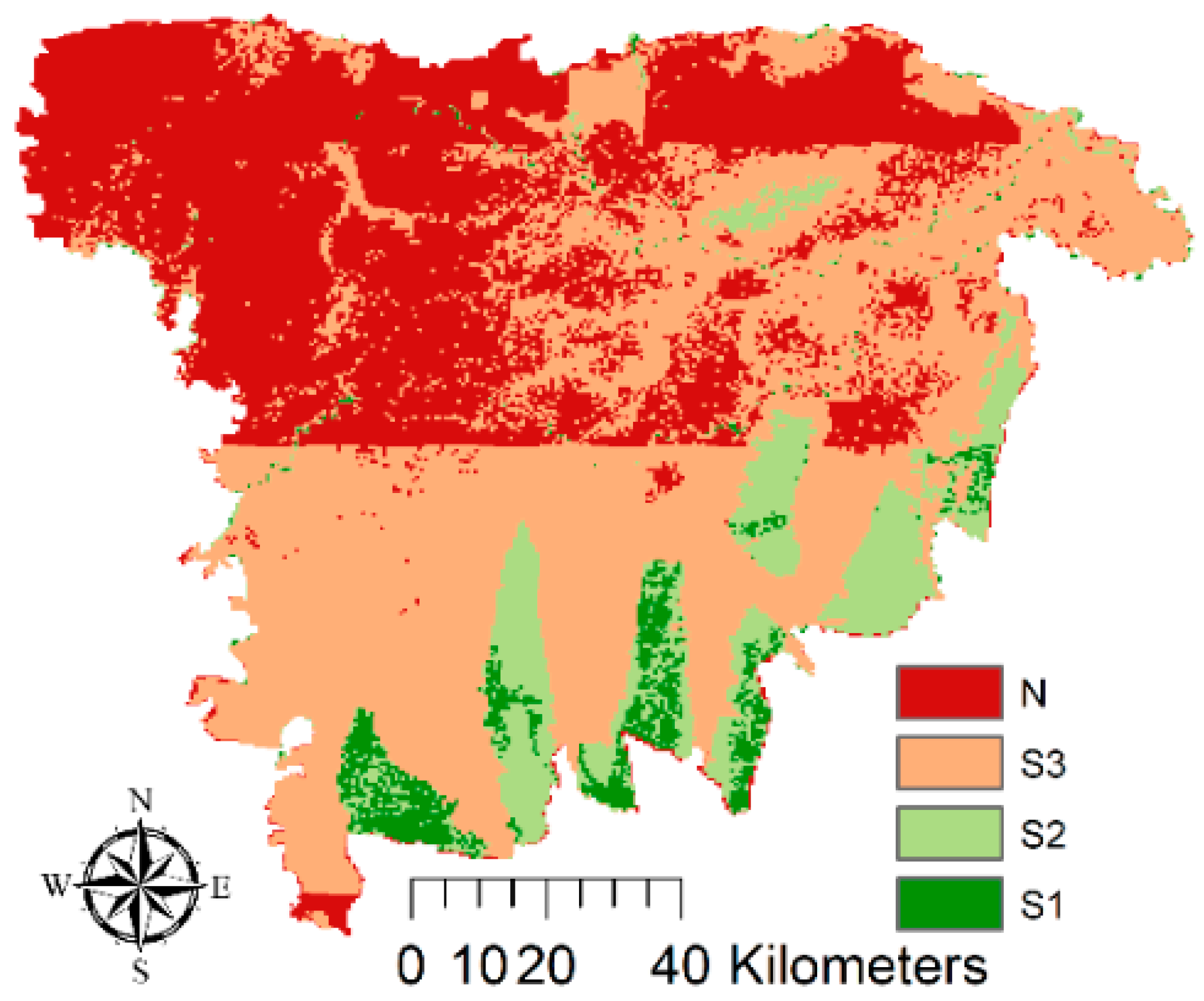
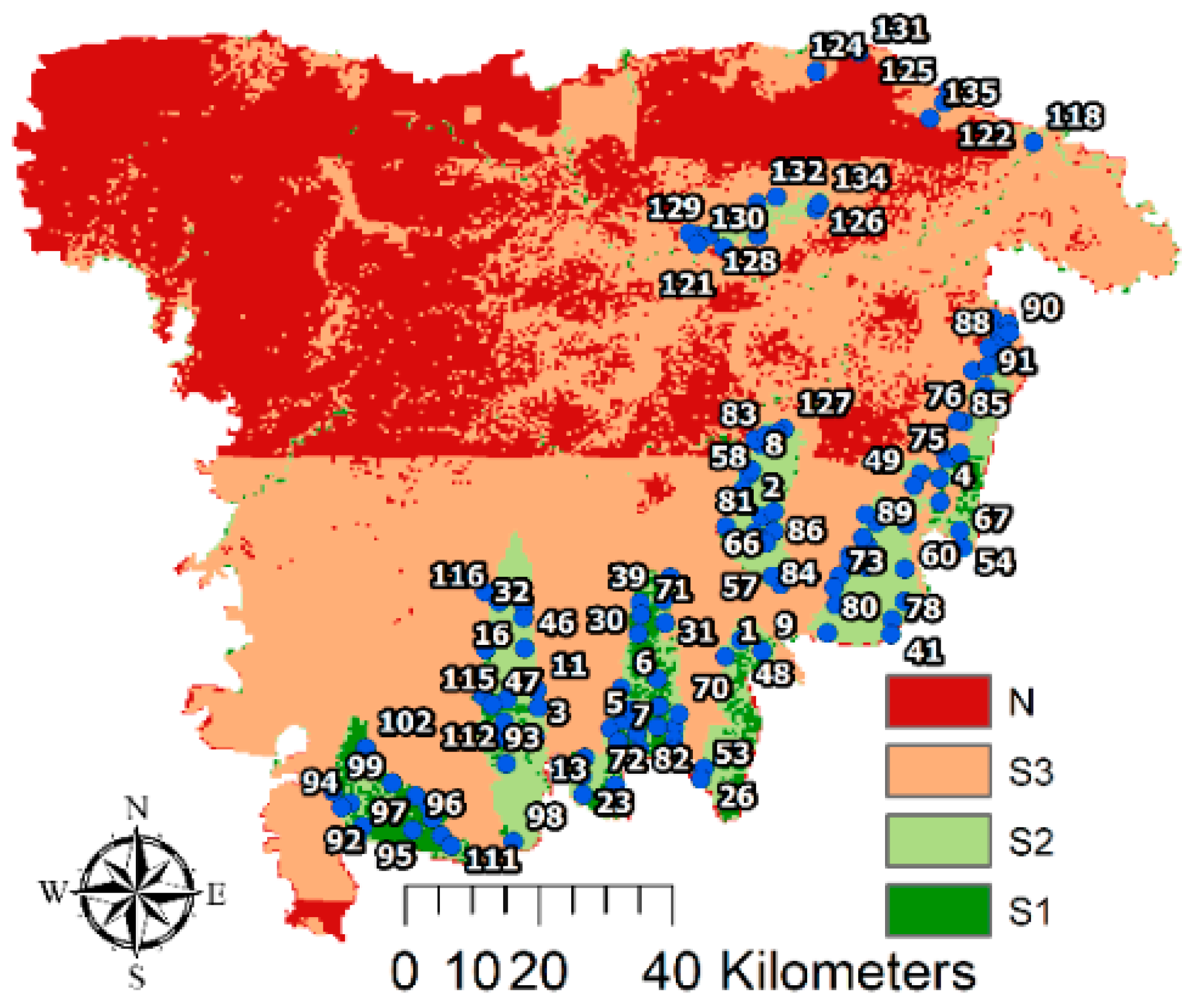

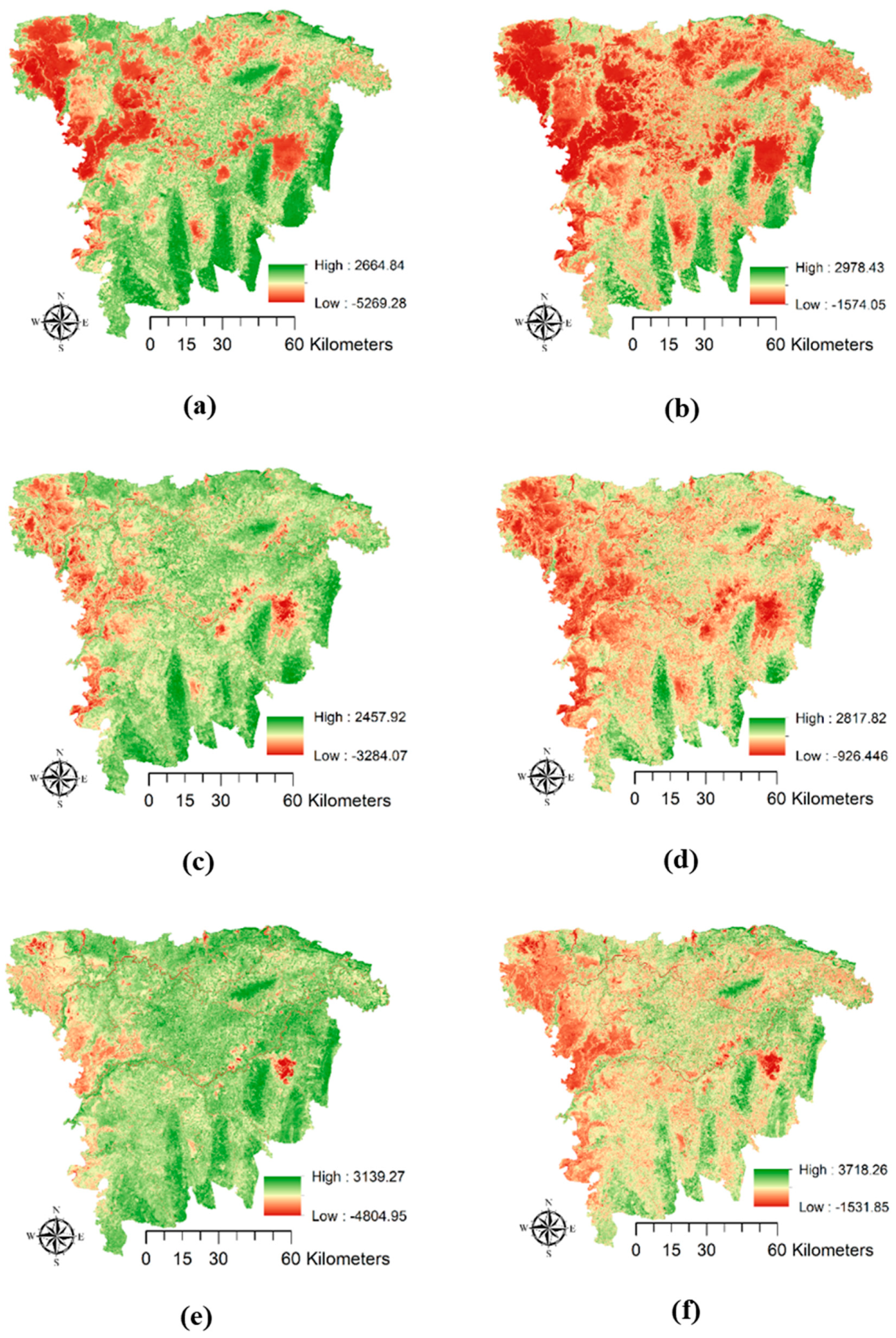
| No. | Data | Description | Source |
|---|---|---|---|
| 1 | Map of LULC | 20 m resolution | Sentinel-2, European Space Agency (ESA), 2019 |
| 2 | Map of NDVI | 20 m resolution | Sentinel-2, European Space Agency (ESA), 2019 |
| 3 | Map of elevation | 30 m resolution | Shuttle Radar Topography Mission (SRTM), NASA, 2019 |
| 4 | Map of precipitation | Scale 1:50,000 | Bangladesh Agricultural Research Council (BARC), 2019 |
| 5 | Map of temperature | Scale 1:50,000 | Bangladesh Agricultural Research Council (BARC), 2019 |
| 6 | Map of slope | Scale 1:50,000 | Bangladesh Agricultural Research Council (BARC), 2019 |
| 7 | Map of soil texture | Scale 1:50,000 | Bangladesh Agricultural Research Council (BARC), 2019 |
| 8 | Map of soil pH | Scale 1:50,000 | Bangladesh Agricultural Research Council (BARC), 2019 |
| 9 | Map of drainage | Scale 1:50,000 | Bangladesh Agricultural Research Council (BARC), 2019 |
| 10 | Map of soil type | Scale 1:50,000 | Bangladesh Agricultural Research Council (BARC), 2019 |
| 11 | Map of distance from Roads | Scale 1:50,000 | Bangladesh Agricultural Research Council (BARC), 2019 |
| 12 | Map of distance from Rivers | Scale 1:50,000 | Bangladesh Country Almanac (BCA), 2019 |
| 13 | Location of tea estates | GPS data | Field survey, 2019 |
| 14 | Tea production | Statistical data | Bangladesh Tea Board (BTB), 2017–2019 |
| Criteria | Suitability Classes | Values/Sub-Criteria | Area (%) | Area (ha) |
|---|---|---|---|---|
| LULC | S1 | Tea estates | 16.41 | 201,818 |
| S2 | Forest | 10 | 123,008 | |
| S3 | High agricultural land | 11.87 | 145,964 | |
| N | Settlements, water bodies, rivers, and wetlands | 61.72 | 759,050 | |
| NDVI | S1 | >0.6 | 2.31 | 28,362 |
| S2 | 0.4–0.6 | 26.51 | 325,998 | |
| S3 | 0–0.4 | 67.77 | 833,430 | |
| N | <0 | 3.42 | 42,051 | |
| Elevation | S1 | >15 m | 35.05 | 431,045 |
| S2 | 10–15 m | 28.75 | 353,533 | |
| S3 | 7–10 m | 22.28 | 274,016 | |
| N | <7 m | 13.92 | 171,246 | |
| Precipitation | S1 | >1800 mm | 38.18 | 469,553 |
| S2 | 1600–1800 | 46.54 | 572,386 | |
| S3 | 1000 + 1600 | 15.28 | 187,901 | |
| Temperature | S1 | 18–25 °C | 100 | 1,229,840 |
| Slope | S1 | 5–25° | 14.73 | 181,103 |
| S2 | <5° | 85.12 | 1046,828 | |
| S3 | >25° | 0.16 | 1909 | |
| Soil texture | S1 | scl, l, cl, sl | 71.36 | 877,555 |
| S2 | c, sicl, sic | 27.22 | 334,729 | |
| S3 | c(ss), ls, s | 1.43 | 17,556 | |
| Soil pH | S1 | 4.5–5.5 | 13.99 | 172,008 |
| S2 | 5.5–7.3 | 81.05 | 996,795 | |
| S3 | 7.3–8.4 | 4.96 | 61,037 | |
| Drainage | S1 | Moderately well drained to well drained | 13.36 | 164,353 |
| S2 | Imperfectly drained | 9.60 | 118,083 | |
| S3 | Poorly drained | 66.30 | 815,421 | |
| N | Very poorly drained | 10.73 | 131,983 | |
| Soil type | S1 | Brown hill soils | 13.24 | 162,782 |
| S2 | Gray piedmont soils | 11.84 | 145,659 | |
| S3 | Non-calcareous alluvium, Brown flood plain soils, Dark gray flood plain soils, Gray flood plain soils, Acid basin clays, Deep-red brown terrace soils | 73.72 | 906,642 | |
| N | Peat, Water bodies, Urban | 1.20 | 14,757 | |
| Distance from roads | S1 | 0–1.0 km | 13.97 | 171,759 |
| S2 | 1.0–2.0 km | 14.51 | 148,404 | |
| S3 | 2.0–4.0 km | 21.81 | 268,246 | |
| N | >4.0 km | 49.72 | 611,431 | |
| Distance from rivers | S1 | 0–0.5 km | 6.23 | 76,601 |
| S2 | 0.5–1.0 km | 11.68 | 143,618 | |
| S3 | 1.0–2.0 km | 18.03 | 221,779 | |
| N | >2.0 km | 64.06 | 787,842 |
| Scale | Degree of Preference | Description |
|---|---|---|
| 1 | Equal Importance | Two factors contribute equally |
| 3 | Moderate importance of one factor over other factor | Experience and judgment slightly favor one over another |
| 5 | Strong importance | Experience and judgment strongly favor one over another |
| 7 | Very strong importance | Experience and judgment very strongly favor one over another |
| 9 | Extreme importance | The evidence favoring one over another is of the highest possible order of affirmation |
| 2,4,6,8 | Intermediate values between two adjacent scales | When compromise is required |
| Reciprocals | Opposite of the above | Used for inverse comparisons |
| Criteria | LULC | NDVI | Elevation | Precipitation | Temperature | Slope | Soil Texture | Soil pH | Drainage | Soil Type | Distance from Roads | Distance from Rivers |
|---|---|---|---|---|---|---|---|---|---|---|---|---|
| LULC | 1 | 1 | 0.33 | 0.14 | 0.20 | 0.20 | 0.33 | 0.20 | 0.14 | 0.33 | 0.33 | 0.33 |
| NDVI | 1 | 1 | 0.33 | 0.11 | 0.14 | 0.20 | 0.33 | 0.20 | 0.14 | 0.33 | 0.33 | 0.33 |
| Elevation | 3 | 3 | 1 | 0.20 | 0.33 | 0.33 | 1 | 0.33 | 0.20 | 1 | 1 | 1 |
| Precipitation | 7 | 9 | 5 | 1 | 3.00 | 5.00 | 5 | 3 | 1 | 5 | 7 | 7 |
| Temperature | 5 | 7 | 3 | 0.33 | 1 | 3.00 | 5 | 5 | 0.20 | 5 | 5 | 5 |
| Slope | 5 | 5 | 3 | 0.20 | 0.33 | 1 | 3 | 1 | 0.33 | 3 | 3 | 3 |
| Soil texture | 3 | 3 | 1 | 0.20 | 0.20 | 0.33 | 1 | 0.33 | 0.20 | 1 | 3 | 3 |
| Soil pH | 5 | 5 | 3 | 0.33 | 0.20 | 3.00 | 1 | 1 | 0.33 | 3 | 5 | 5 |
| Drainage | 7 | 7 | 5 | 1 | 5.00 | 3.00 | 5 | 3.00 | 1 | 5 | 7 | 7 |
| Soil type | 3 | 3 | 1 | 0.20 | 0.20 | 0.33 | 1 | 0.33 | 0.20 | 1 | 1 | 1 |
| Distance from roads | 3 | 3 | 1 | 0.14 | 0.20 | 0.33 | 0.33 | 0.20 | 0.14 | 1 | 1 | 1 |
| Distance from rivers | 3 | 3 | 1 | 0.14 | 0.20 | 0.33 | 0.33 | 0.20 | 0.14 | 1 | 1 | 1 |
| Criteria | LULC | NDVI | Elevation | Precipitation | Temperature | Slope | Soil Texture | Soil pH | Drainage | Soil Type | Distance from Roads | Distance from Rivers |
|---|---|---|---|---|---|---|---|---|---|---|---|---|
| LULC | 0.022 | 0.020 | 0.014 | 0.036 | 0.018 | 0.012 | 0.014 | 0.014 | 0.035 | 0.013 | 0.010 | 0.010 |
| NDVI | 0.022 | 0.020 | 0.014 | 0.028 | 0.013 | 0.012 | 0.014 | 0.014 | 0.035 | 0.013 | 0.010 | 0.010 |
| Elevation | 0.065 | 0.060 | 0.041 | 0.050 | 0.030 | 0.020 | 0.043 | 0.023 | 0.050 | 0.038 | 0.029 | 0.029 |
| Precipitation | 0.152 | 0.180 | 0.203 | 0.250 | 0.272 | 0.293 | 0.214 | 0.203 | 0.248 | 0.188 | 0.202 | 0.202 |
| Temperature | 0.109 | 0.140 | 0.122 | 0.083 | 0.091 | 0.176 | 0.214 | 0.338 | 0.050 | 0.188 | 0.144 | 0.144 |
| Slope | 0.109 | 0.100 | 0.122 | 0.050 | 0.030 | 0.059 | 0.129 | 0.068 | 0.083 | 0.113 | 0.087 | 0.087 |
| Soil texture | 0.065 | 0.060 | 0.041 | 0.050 | 0.018 | 0.020 | 0.043 | 0.023 | 0.050 | 0.038 | 0.087 | 0.087 |
| Soil pH | 0.109 | 0.100 | 0.122 | 0.083 | 0.018 | 0.176 | 0.043 | 0.068 | 0.083 | 0.113 | 0.144 | 0.144 |
| Drainage | 0.152 | 0.140 | 0.203 | 0.250 | 0.454 | 0.176 | 0.214 | 0.203 | 0.248 | 0.188 | 0.202 | 0.202 |
| Soil type | 0.065 | 0.060 | 0.041 | 0.050 | 0.018 | 0.020 | 0.043 | 0.023 | 0.050 | 0.038 | 0.029 | 0.029 |
| Distance from roads | 0.065 | 0.060 | 0.041 | 0.036 | 0.018 | 0.020 | 0.014 | 0.014 | 0.035 | 0.038 | 0.029 | 0.029 |
| Distance from rivers | 0.065 | 0.060 | 0.041 | 0.036 | 0.018 | 0.020 | 0.014 | 0.014 | 0.035 | 0.038 | 0.029 | 0.029 |
| n | 1 | 2 | 3 | 4 | 5 | 6 | 7 | 8 | 9 | 10 | 11 | 12 | 13 | 14 | 15 |
|---|---|---|---|---|---|---|---|---|---|---|---|---|---|---|---|
| RI | 0 | 0 | 0.58 | 0.9 | 1.12 | 1.24 | 1.32 | 1.41 | 1.45 | 1.49 | 1.51 | 1.48 | 1.56 | 1.57 | 1.59 |
| Components | Forests | Tea Estates | Water Bodies | Settlements | High Agril. Land | Rivers | Wet Lands | Total (User) | % Accuracy |
|---|---|---|---|---|---|---|---|---|---|
| Forests | 7 | 0 | 0 | 0 | 0 | 0 | 0 | 7 | 100 |
| Tea Estates | 0 | 7 | 0 | 0 | 0 | 0 | 0 | 7 | 100 |
| Water Bodies | 0 | 0 | 6 | 0 | 0 | 0 | 1 | 7 | 85.71 |
| Settlements | 1 | 0 | 0 | 6 | 0 | 0 | 0 | 7 | 85.71 |
| High Agril. Land | 0 | 0 | 0 | 0 | 7 | 0 | 0 | 7 | 100 |
| Rivers | 0 | 0 | 0 | 0 | 0 | 5 | 2 | 7 | 71.43 |
| Wetlands | 0 | 0 | 0 | 0 | 0 | 0 | 8 | 8 | 100 |
| Total (Producer) | 8 | 7 | 6 | 6 | 7 | 5 | 11 | 50 | |
| % Accuracy | 87.5 | 100 | 100 | 100 | 100 | 100 | 100 |
| Criteria | Expert A (30 Years) | Expert B (10 Years) | Expert C (12 Years) | Expert D (12 Years) | Expert E (8 Years) | Expert F (10 Years) | Expert G (12 Years) | Expert H (15 Years) | Expert I (12 Years) | Expert J (8 Years) | Average | Weight |
|---|---|---|---|---|---|---|---|---|---|---|---|---|
| LULC | 0.024 | 0.023 | 0.022 | 0.033 | 0.037 | 0.038 | 0.030 | 0.018 | 0.019 | 0.020 | 0.026 | 3 |
| NDVI | 0.024 | 0.018 | 0.022 | 0.021 | 0.020 | 0.017 | 0.034 | 0.017 | 0.019 | 0.021 | 0.021 | 2 |
| Elevation | 0.035 | 0.040 | 0.051 | 0.088 | 0.058 | 0.068 | 0.054 | 0.040 | 0.063 | 0.047 | 0.054 | 5 |
| Precipitation | 0.214 | 0.244 | 0.248 | 0.200 | 0.249 | 0.258 | 0.202 | 0.217 | 0.232 | 0.205 | 0.227 | 23 |
| Temperature | 0.133 | 0.177 | 0.133 | 0.145 | 0.135 | 0.181 | 0.155 | 0.150 | 0.142 | 0.129 | 0.148 | 15 |
| Slope | 0.095 | 0.082 | 0.090 | 0.078 | 0.077 | 0.066 | 0.076 | 0.086 | 0.071 | 0.100 | 0.082 | 8 |
| Soil texture | 0.066 | 0.045 | 0.048 | 0.048 | 0.049 | 0.038 | 0.055 | 0.048 | 0.052 | 0.048 | 0.050 | 5 |
| Soil pH | 0.104 | 0.105 | 0.085 | 0.091 | 0.108 | 0.095 | 0.114 | 0.100 | 0.093 | 0.089 | 0.098 | 10 |
| Drainage | 0.186 | 0.182 | 0.191 | 0.200 | 0.178 | 0.157 | 0.189 | 0.219 | 0.207 | 0.226 | 0.194 | 19 |
| Soil type | 0.071 | 0.046 | 0.065 | 0.053 | 0.051 | 0.041 | 0.050 | 0.039 | 0.062 | 0.050 | 0.053 | 5 |
| Distance from roads | 0.024 | 0.019 | 0.023 | 0.023 | 0.020 | 0.020 | 0.020 | 0.033 | 0.020 | 0.020 | 0.022 | 2 |
| Distance from rivers | 0.024 | 0.019 | 0.023 | 0.023 | 0.020 | 0.020 | 0.020 | 0.033 | 0.020 | 0.046 | 0.025 | 3 |
| Suitability Level | Pixel Counts | Area (%) | Area (ha) |
|---|---|---|---|
| S1 (Highly suitable) | 1535 | 3.37 | 41,460 |
| S2 (Moderately suitable) | 4101 | 9.01 | 110,767 |
| S3 (Marginally suitable) | 22,709 | 49.87 | 613,367 |
| N (Not suitable) | 17,188 | 37.75 | 464,246 |
Publisher’s Note: MDPI stays neutral with regard to jurisdictional claims in published maps and institutional affiliations. |
© 2020 by the authors. Licensee MDPI, Basel, Switzerland. This article is an open access article distributed under the terms and conditions of the Creative Commons Attribution (CC BY) license (http://creativecommons.org/licenses/by/4.0/).
Share and Cite
Das, A.C.; Noguchi, R.; Ahamed, T. Integrating an Expert System, GIS, and Satellite Remote Sensing to Evaluate Land Suitability for Sustainable Tea Production in Bangladesh. Remote Sens. 2020, 12, 4136. https://doi.org/10.3390/rs12244136
Das AC, Noguchi R, Ahamed T. Integrating an Expert System, GIS, and Satellite Remote Sensing to Evaluate Land Suitability for Sustainable Tea Production in Bangladesh. Remote Sensing. 2020; 12(24):4136. https://doi.org/10.3390/rs12244136
Chicago/Turabian StyleDas, Animesh Chandra, Ryozo Noguchi, and Tofael Ahamed. 2020. "Integrating an Expert System, GIS, and Satellite Remote Sensing to Evaluate Land Suitability for Sustainable Tea Production in Bangladesh" Remote Sensing 12, no. 24: 4136. https://doi.org/10.3390/rs12244136
APA StyleDas, A. C., Noguchi, R., & Ahamed, T. (2020). Integrating an Expert System, GIS, and Satellite Remote Sensing to Evaluate Land Suitability for Sustainable Tea Production in Bangladesh. Remote Sensing, 12(24), 4136. https://doi.org/10.3390/rs12244136






